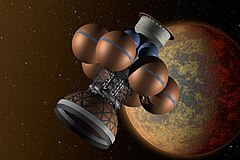
Project Daedalus (named after Daedalus, the Greek mythological designer who crafted wings for human flight) was a study conducted between 1973 and 1978 by the British Interplanetary Society to design a plausible uncrewed interstellar probe.[1] Intended mainly as a scientific probe, the design criteria specified that the spacecraft had to use existing or near-future technology and had to be able to reach its destination within a human lifetime. Alan Bond led a team of scientists and engineers who proposed using a fusion rocket to reach Barnard's Star 5.9 light years away. The trip was estimated to take 50 years, but the design was required to be flexible enough that it could be sent to any other target star.
All the papers produced by the study are available in a BIS book, Project Daedalus: Demonstrating the Engineering Feasibility of Interstellar Travel.[2]
- ^ Project Daedalus Study Group: A. Bond et al., Project Daedalus – The Final Report on the BIS Starship Study, JBIS Interstellar Studies, Supplement 1978
- ^ A. Bond et al., Project Daedalus: Demonstrating the Engineering Feasibility of Interstellar Travel